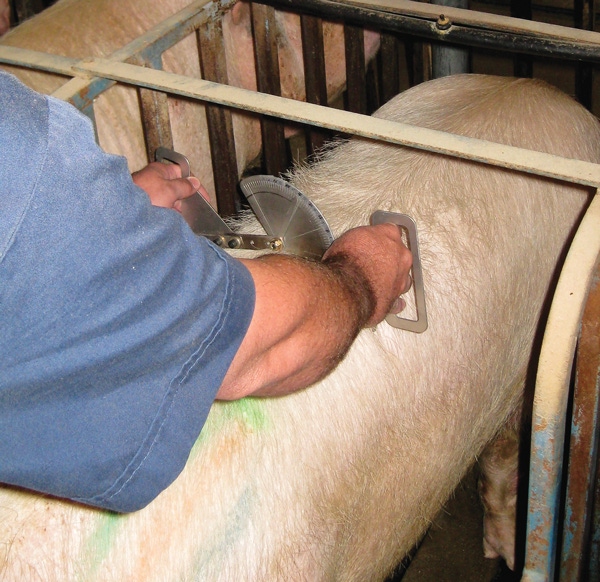Most of the 5.8 million sows in the United States are fed to a subjective body condition target. Yet the majority of barn workers, farm managers and service staff are not highly trained in estimating body composition. And, on some farms, the task of scoring body condition may fall to more than one individual, thus compounding the variation.
June 19, 2012

Most of the 5.8 million sows in the United States are fed to a subjective body condition target. Yet the majority of barn workers, farm managers and service staff are not highly trained in estimating body composition. And, on some farms, the task of scoring body condition may fall to more than one individual, thus compounding the variation.
A new, objective body condition evaluation tool — the sow body condition caliper — was developed at North Carolina State University (NCSU). The caliper can help better train whoever is responsible for sow body condition scoring, as well as the person responsible for setting gestation feeding drop boxes. The goal is to do a better job of feeding sows to maximize their reproductive efficiency and ensure well-being.
The caliper quantifies the angularity of a sow’s top line when viewed from the rear (see photo). The design is based on the premise that as a sow loses muscle and fat, her back becomes more angular. Conversely, as a sow gains muscle and replaces fat along her loin edge, her back appears wider and flatter when viewed from behind.
“The caliper represents the angularity of the sow’s back,” explains Mark Knauer, lead researcher at NCSU. “An increment of one (1) on the caliper scale represents a 1.25-degree change in the angularity of a sow’s back.” Therefore, a lower caliper number (less angle) represents a higher body condition score.
The scoring system can easily be adjusted to fit specific production systems. For example, large production systems may want to do some research to define optimal body condition for their genetic lines, housing and environmental conditions with consideration for the diets fed in gestation. Smaller producers will more likely base their optimal body condition range on data available from genetic suppliers or other public sources.
“I believe the caliper will have three categories — optimal, too thin and too fat,” Knauer adds.
Field Studies
A prototype sow body condition caliper was validated at two North Carolina commercial sow farms with the same facility design, genetics and diet formulations. The primary difference between the two farms was the individuals responsible for adjusting the feed drop boxes.
Data collected from each farm included parity, weight (estimated from heart girth), real-time ultrasound backfat and loin muscle depth measurement at the 10th rib, body condition score assigned by the farm staff, body condition score assigned by an expert (Knauer) and a sow body condition caliper measurement at the last rib.
Trait means for the two farms are shown in Table 1. Farm 2 reported higher average body condition scores by the farm staff and expert scorer in comparison to Farm 1. And the distributions of sow body condition scores between farms were relatively similar. However, further analysis indicated the variation in sow body condition between herds was greater than what the farms reported, Knauer notes.

Figure 1 shows the distribution of body condition scores on the two farms was quite different. Further evidence of a greater difference in weight and backfat are reinforced in Table 1. Farm 2 sows were heavier (545 vs. 486 lb.) and had more 10th rib backfat (1.15 vs. 0.90 in.) in comparison to Farm 1 sows.

Prototypes Available
The sow body condition caliper offers producers an objective, repeatable (r = 0.94) tool that can be used to better train the staff responsible for subjectively evaluating sow body condition. “The tool may also be used by service personnel to settle any debates as to whether a particular farm is over or underfeeding sows,” Knauer notes.
The design of the sow body condition caliper is complete, but prototypes are undergoing further screening in a few North Carolina production systems.
Prototypes of the sow body condition caliper are available for purchase, although price may be dependent upon the buyer’s willingness to share data needed to verify current research and add to the statistical significance of the dataset.
For additional information, contact Mark Knauer at [email protected] or (919) 515-8797. “If mass produced, the cost would be significantly reduced,” he notes.
You May Also Like



